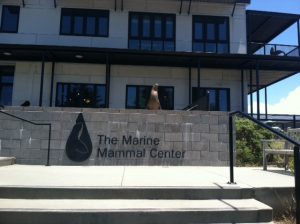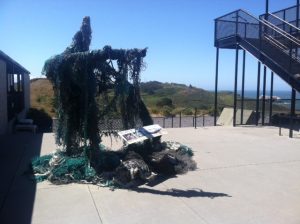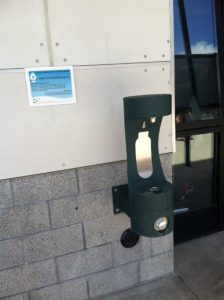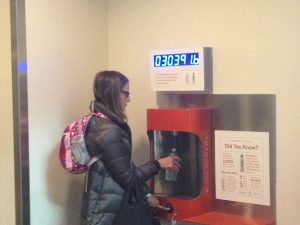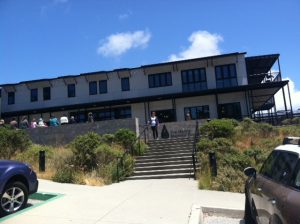A day spent at the Marine Mammal Center in Marin, CA is always an amazing day. My organization, Root Solutions is working with the Marine Mammal Center to help them spread the message about the dangers of marine debris, and the negative effect it is having on all sea creatures, specifically marine mammals. So in order to better understand what this project is going to look like and how Root Solutions can help, a group of us were lucky enough to spend the morning being VIP’s at the Marine Mammal Center with our fantastic guide Adam.
 He taught us so many cool things about marine mammals, like how to tell the difference between a Sea Lion and a Harbor Seal – it’s all about the ears and flippers! California Sea Lions have these clearly visible ear flaps and long front flippers, while Pacific Harbor Seals only have tiny ear holes, and much shorter flippers with paws on the end. When asked, “what about the otters?!,” Adam explained how young otters need other otters to teach them the skills they need to survive in the wild. Apparently, humans make really lousy otters. So when the MMC gets a call, they will go out and rescue the distressed otter, but instead of bringing it back to MMC will then bring it down to the Monterey Bay Aquarium, where there is an entire facility dedicated to otter rehabilitation.
He taught us so many cool things about marine mammals, like how to tell the difference between a Sea Lion and a Harbor Seal – it’s all about the ears and flippers! California Sea Lions have these clearly visible ear flaps and long front flippers, while Pacific Harbor Seals only have tiny ear holes, and much shorter flippers with paws on the end. When asked, “what about the otters?!,” Adam explained how young otters need other otters to teach them the skills they need to survive in the wild. Apparently, humans make really lousy otters. So when the MMC gets a call, they will go out and rescue the distressed otter, but instead of bringing it back to MMC will then bring it down to the Monterey Bay Aquarium, where there is an entire facility dedicated to otter rehabilitation.
MMC is already utilizing many different behavior design techniques for fostering real change in its guests, which made us all smile and get so excited. Throughout his tour, Adam was constantly using metaphors to reinforce that connection between humans and animal physiology- think of the ozone layer as this giant heat trapping blanket, and each year as more CO2 emissions are released that blanket gets thicker and thicker.
Or my personal favorite which I plan on using all the time – think of rising water temperatures as the ocean having a fever, which like all diseases is spreading and making all of the plants and animals who live in the ocean sick. Genius! Love metaphors so much 🙂
Looking out over the pens and pools holding the current residents of MMC, you really get a sense of how disruptive our actions are to their lives. Adam told us how most of the patients are there because of marine trash – either ingesting it, getting tangled in it, or getting sick from it. There are way more of us than there are of them. We need to remember that the ocean is THEIR home not ours, and just as you would want someone coming into your home to be respectful of your space, those animals and their homes deserve the same level of respect. Because after all, we’re all creatures of this earth … we are all from the same earthling family.
Another fantastic behavioral technique the MMC is already using is storytelling – which can be incredibly powerful and impactful for the audience. The most visually striking story told by the MMC is the tale of the Ghost Trash Monster – trust me you can’t miss it.
This massive sculpture was made out of only a portion of netting that was pulled from the stomach of a dead Sperm whale who had washed up on shore of Monterey Bay. Adam told us how the whale had no outward signs of injury or disease.
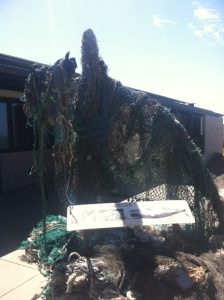 They didn’t know what had killed the poor animal until they opened him up and actually looked at the stomach contents. This whale had 100’s of pounds of plastic in his gut – ranging from plastic bottles to plastic bags to plastic fishing nets. Adam said that they are getting more and more patients suffering from problems due to marine plastic, whether it’s seal and sea lions coming in with plastic fishing line wrapped around their snouts so they can’t eat, or they’re going out to save whales trapped in fishing nets. If there is one thing you learn from looking at this massive statue it’s that ocean litter, specifically plastic, is a serious problem that is only getting worse.
They didn’t know what had killed the poor animal until they opened him up and actually looked at the stomach contents. This whale had 100’s of pounds of plastic in his gut – ranging from plastic bottles to plastic bags to plastic fishing nets. Adam said that they are getting more and more patients suffering from problems due to marine plastic, whether it’s seal and sea lions coming in with plastic fishing line wrapped around their snouts so they can’t eat, or they’re going out to save whales trapped in fishing nets. If there is one thing you learn from looking at this massive statue it’s that ocean litter, specifically plastic, is a serious problem that is only getting worse.
Along that plastic vein, upon entering the MMC we were told that if we brought water bottles with us there is a filling station inside. We all nearly jumped for joy – the MMC was utilizing behavior norming! Planting the idea in visitors heads that it’s totally normal for people to carry water bottles with them – how fantastic is that. The water filling station was good – but it could be better.
The filling station was clearly visible and had some information along with it. However, because the MMC is pushing the idea of reducing our use of plastics, it would be more effective to have a different type of water bottle refilling station which reinforces that message. And wouldn’t you know, those happen to exist!
These new(er) water bottle refilling stations are super cool because they have a big LED screen with a running ticker of how many plastic water bottles are being saved because people are using the water fountain. So you can actually see the positive impact your choice to bring a reusable bottle is having on the environment. How awesome is that?!
All of us at Root Solutions are ecstatic to have this opportunity to work with the Marine Mammal Center. We saw so many things they were doing right in terms of behavioral design techniques- telling stories, using metaphors, identifying victims with names and a personal history, mentioning water bottle refilling stations upon entry to the MMC, and ending the tours on a hopeful and thankful note – telling everyone that just by visiting today they are already making a positive change in the environment. We can’t wait get started! 🙂

